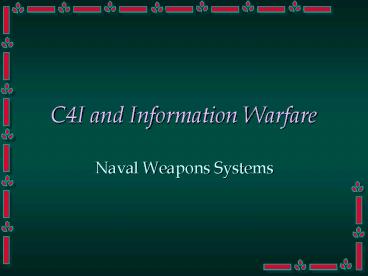C4I and Information Warfare - PowerPoint PPT Presentation
1 / 27
Title: C4I and Information Warfare
1
C4I and Information Warfare
- Naval Weapons Systems
2
Putting It All Together - C4I
Command
Computers
C4I
Control
Intelligence
Communications
3
Why We Need C4I
Faster response times required. Joint
Operations require high levels of coordination.
More sophisticated weapons require more
information.
4
Functions of C4I
- Creates a common tactical picture. Ensures all
information is available to operators
commanders. - Ensures connectivity and information exchange.
- Sends information directly from sensor to
shooter. - Support and uses information warfare (IW).
5
Command and Control Warfare
Objectives
1. Defeat the enemy by destroying its C2W
systems. 2. Separate the enemys command
structure from its forces. 3. Protect
ones own C2W forces. 4. Connect commanders and
forces.
6
Characteristics
- Reliable
- Secure
- Timely
- Flexible
- Interoperable
- Survivable
7
Tools to Achieve C2W Objectives
- Operational Security
- Military Deception
- Psychological Operations
- Electronic Warfare
- Physical Destruction
8
C2W Decision Making Cycle
Observe
Orient
Act
Decide
(OODA loop)
9
Intelligence
Product of collecting, exploiting, processing,
integrating, analyzing and interpreting informati
on.
Types
1. Strategic Intelligence 2. Tactical
Intelligence
10
Function of Intelligence
- Prepare the Battlespace
- Define environment or physical characteristics.
- Evaluate the threat and the threats course of
action. - Provide Early Warning
- Evaluate the situation (current actions
changes) - Identify and Target the Enemys Vulnerabilities
- Assess Battle Damage (own and enemys)
- Manage Intelligence Information
- Prevent Enemys Intelligence Efforts (Offensive
Defensive)
11
Information Warfare (IW)
IW is action taken to preserve the integrity of
own information systems from exploitation,
disruption, and destruction while achieving an
information advantage over the enemy.
12
IW Tools
- Surveillance Systems
- Satellites
- Electronic Warfare and Signal Intelligence
- Human Intelligence
- Communications Systems
- Tactical Network
- Computers
- Database management
13
Navy Tactical Data System (NTDS)
Interceptor
Interceptor
Early Warning Aircraft
Link 4A
Link 4A
Link 11
Link 11
Link 14
NTDS Ship
Non-NTDS Ship
NTDS Ship
14
(No Transcript)
15
NTDS
- Navy Tactical Data System
- Purpose
- Allows data collected from multiple platforms to
be shared - Users Ships, planes, shore stations
- Link 4A
- Link 11
- Link 16
16
What info does it share?
- Contact info
- Type of contact
- ID / Track
- Course / Speed
- Altitude
- IFF Mode
- Weapons / sensor status of others
17
How does it work?
- It takes sensor data from each user and creating
a common picture and distributes the info to all
users - Requires constant human interface, especially in
ID ing contacts
18
Symbology
- Once the identification process has been
completed, corresponding symbology is placed on
the track so everyone can know the ID.
19
Symbology
- Friendly tracks are circles or half circles
depending on platform - Unknown are squares or half squares
- Hostiles are diamonds or half diamonds
20
Optasks
- Optasks are governing instructions used by a
battle group. Tell you how to conduct business - Optask for each warfare area
- Differ in every area of the world based on threat
and geopolitical situation
21
Identification
- Hardest part
- Optask ID contains template / flowchart for
identifying contacts as friendly, unknown, or
hostile. - Based on some of the following
- IFF, Altitude, Profile, Where it came from, Com
air routes, VID
22
IFF
- Identification friend or foe
- M 1 - Mission
- M 2 - Squadron
- M 3 - General squawk, all have it
- M 4 - US or allied
- Transponder on aircraft / ship sends and receives
IFF signal
23
Track info
- TN / ID Which ship made ID
- Location Lat / Long
- Cse / Spd
- Alt
- IFF
- CPA
- Amp Data
24
Data Link
- Limitations
- range
- equipment
- operators
- jamming (link 16 jam resistant frequency agile)
25
Communications Security
Protection resulting from all measures designed
to deny unauthorized persons information and the
possession of telecommunications data. Called
CMS.
Elements
Crypto Security Transmission Security Emission
Security Physical Security
26
Computer Requirements
- Sort, process, organize, correlate, and
disseminate information in near real-time. - Blend critical tactical, operational and
administrative data to meet tactical objectives. - Present information in a multi-media format to
best suit the operator or equipment - Have a standardize equipment to reduce training
and increase proficiency - Have standardized hardware design to allow
upgrade and additions to equipment.
27
Inherent Problems With Automated Systems
1. Evaluation 2. Orientation 3. Cost 4.
Decision Making 5. Discipline 6. Survivability

